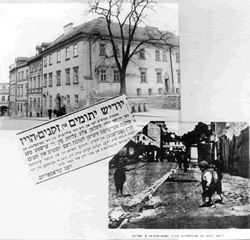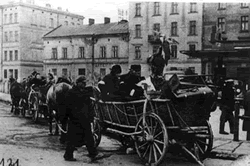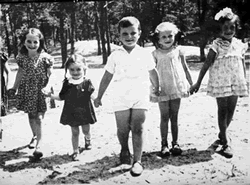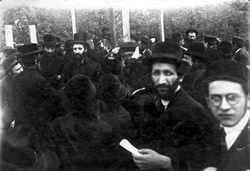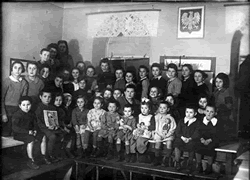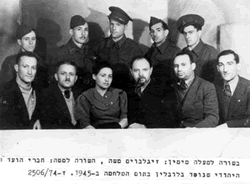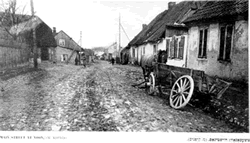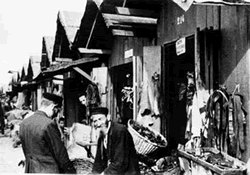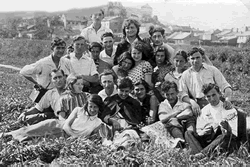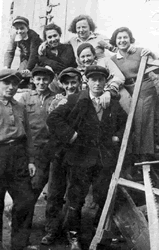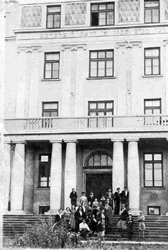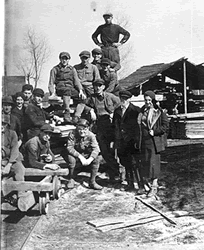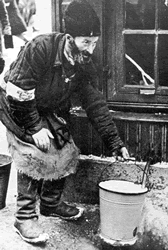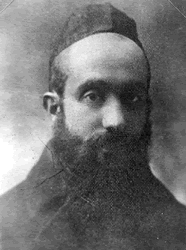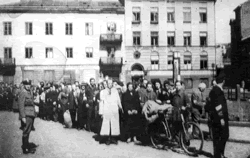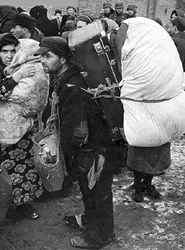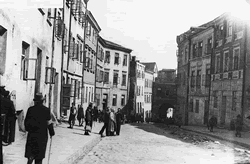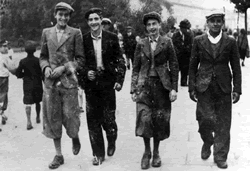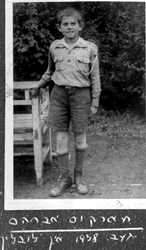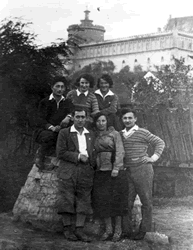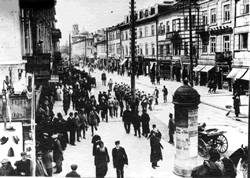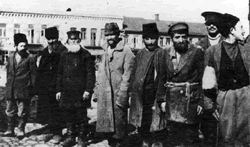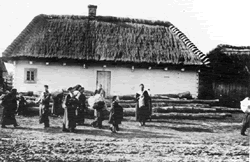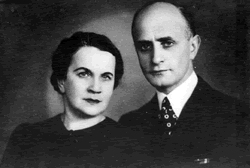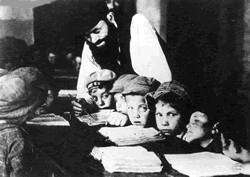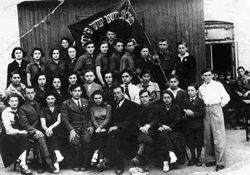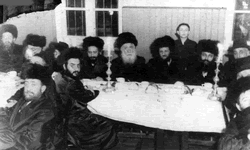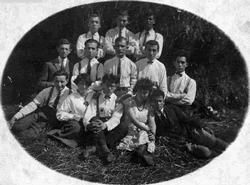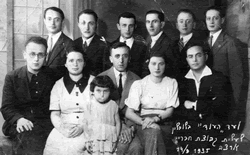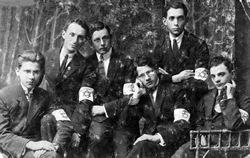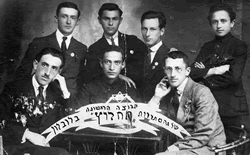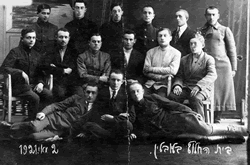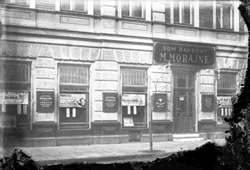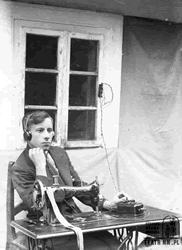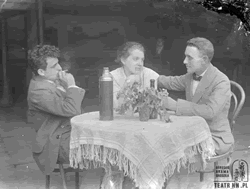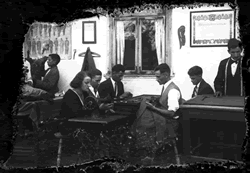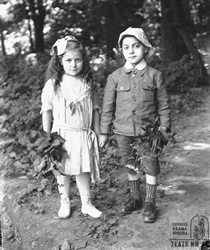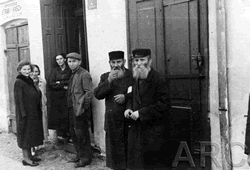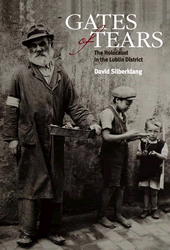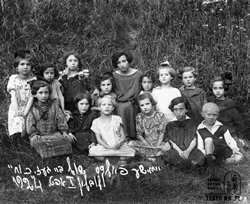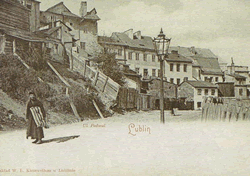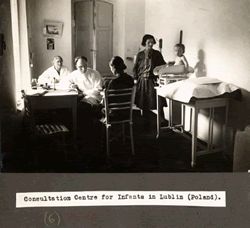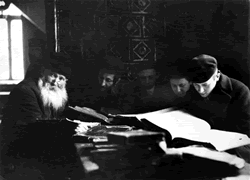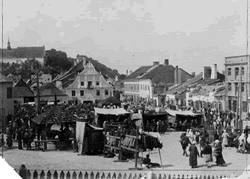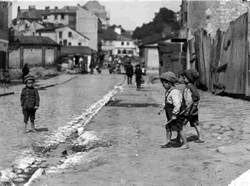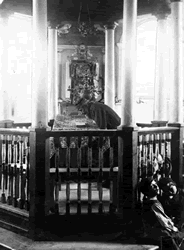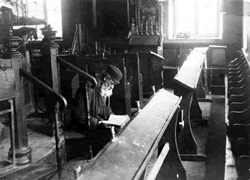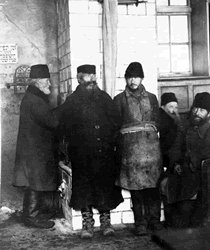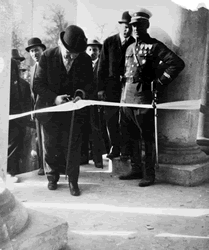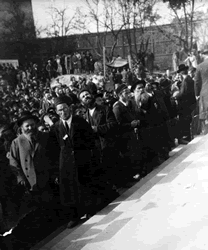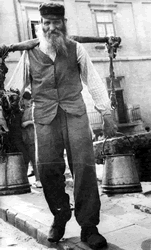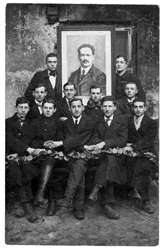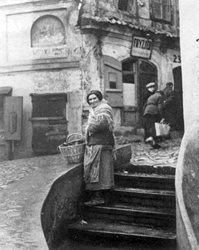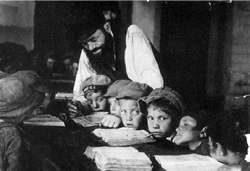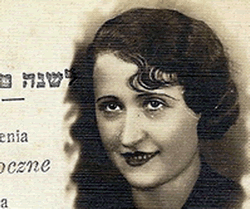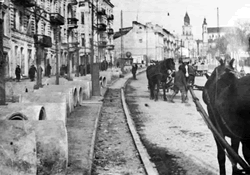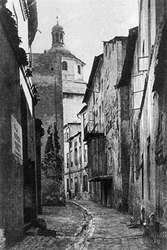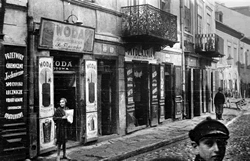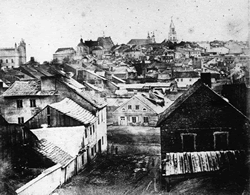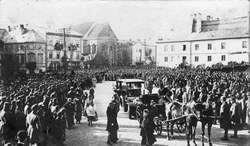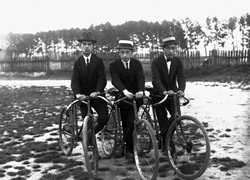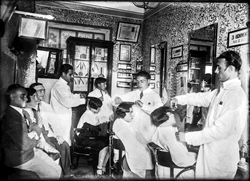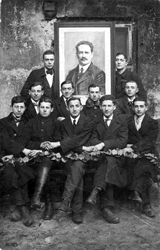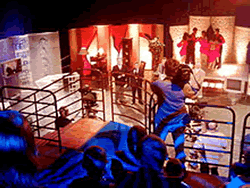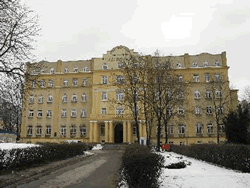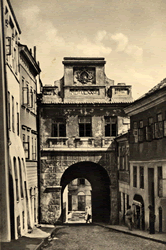|
#lbln-1:
|
#lbln-2:
|
#lbln-3: Jewish children, lublin 1930s |
|
#lbln-4: Hasidim 1930's |
#lbln-5: Children's home 1944 (immediately after the liberation) |
#lbln-6:
|
|
#lbln-7:
|
#lbln-8:
|
#lbln-9: Members of Hachalutz Hazair in Lublin 1933 |
|
#lbln-10: Lublin 1935 |
#lbln-11: 1933 |
#lbln-12: Members of Hashomer Hazair in Lublin 1930s |
#lbln-13: In the Lublin Ghetto |
#lbln-14: Rabbi Shlomo Halberstadt, a Radzyn Chasid, member of the Jewish Community Council in Lublin and afterwards chairman of the community. |
#lbln-15: A Jewish ghetto policeman at the head of a column of Jews being deported from the Lublin ghetto. |
#lbln-16: In the Lublin Ghetto |
#lbln-17: |
#lbln-18: Gordonia Youth movement members in Lublin |
#lbln-19: |
#lbln-20: |
#lbln-21: |
#lbln-22: Lublin's Jews during the first world war. |
#lbln-23: Jews fleeing the combat area during the first world war. |
#lbln-24: Leaders of the bund. Jakov Nissenbaum (editor of the "Lubliner Tagblat" perished in the holocaust) and Bela Szapiro (a member of the Lublin city council until 1939). |
#lbln-25: A heder (small school) in Lublin 1924 |
#lbln-26: 1932 Skip Youth ( socialists) |
#lbln-27: Rabbis and guests in the Yeshivat Chakhmei Lublin rabbinic seminary. Photographed in 1936 |
#lbln-28: Lublin 1924 |
#lbln-29: 1935 Lublin |
#lbln-30: Lublin 1922 |
#lbln-31: Lublin early 1920's |
#lbln-32: |
#lbln-33: |
#lbln-34: |
#lbln-35: |
#lbln-36: |
#lbln-37: |
#lbln-38: |
#lbln-39: |
#lbln-40: |
#lbln-41: |
#lbln-42: Lublin, 1930. At the Consultation Center for Infants |
#lbln-43: 1927 studying at the synagogue |
#lbln-44: The market place |
#lbln-45: 1920's Lublin |
#lbln-46: Lublin synagogue 1924 |
#lbln-47: |
#lbln-48: By the synagogue |
#lbln-49: The opening of the Lublin yeshiva 1937. |
#lbln-50: |
#lbln-51: Lublin 1937 |
#lbln-52: Framed portrait of Ber Borochov. The group takes a picture before going into the Polish army at the age of 21.The year 1919. |
#lbln-53: The Jewish quarter in the old section of Lublin, 1938: |
#lbln-54: Lublin, 1924. |
#lbln-55: Bronia Feigenbaum |
#lbln-56: |
#lbln-57: |
#lbln-58: |
#lbln-59: |
#lbln-60: |
#lbln-61: |
#lbln-62: |
#lbln-63: Lublin, 1919. A group of men, all born in 1898, pose with a framed portrait of Ber Borochov, a founder of the Labor Zionist movement, on the eve of their induction into the Polish army at the age of 21. |
#lbln-64: |
#lbln-65: |
#lbln-66: |
|
|
http://www.jewishvirtuallibrary.org/jsource/vjw/Lublin.html
Lublin [?lubl?in] Ukrainian: ??????, Liublin, Yiddish: ?????? Lublin) is the ninth largest city in Poland, and the second largest city of Lesser Poland. It is the capital of Lublin Voivodeship (province) with a population of 349,103 (March 2011).
http://en.wikipedia.org/wiki/Lublin
History of Jewish Lublin; Jews settled in Lublin from c 1330. In 1336 King Kazimierz Wielki (Casimir the Great) granted them the privilege to settle down in the so-called Podzamcze area (literally it means “at the bottom of the castle”).
http://lublin.jewish.org.pl/history.html
Please share your comments or photos or links for posting on our Guestbook Page here: egl.comments@gmail.com
http://en.wikipedia.org/wiki/Lublin
History;
The first permanent settlements on the future site of Lublin were established in the early Middle Ages, though archeological finds indicate a long, earlier presence of cultures in the general area. The earliest, most significant settlement began in the 6th century on a hill in the suburb of Czwartek (in Polish Thursday, most likely in reference to the market day of the settlement). It is likely that the surrounding hills, site of the present day Old Town, were settled at this time. In the 10th and 11th centuries, the Czwartek settlement became an important trade centre. The location of Lublin at the eastern borders of the Polish lands gave it military significance. The first fortification on the site may have been built as early as the 8th century, possibly on the Castle Hill. Certainly at the end of the 10th century a significant fortification existed there. As the castle grew, the Old Town hill adjacent to it became the main focus of settlement, and the Czwartek settlement declined in relative importance. The castle became the seat of a Castellan, first mentioned in historical sources from 1224, but quite possibly present from the start of the 12th or even 10th century. The oldest historical document mentioning Lublin dates from 1198, so the name must have come into general use some time earlier.
The city was a target of attacks by Tatars, Ruthenes, Yotvingians, and Lithuanians and was destroyed several times. It was also ruled by Kingdom of Galicia–Volhynia between 1289 and 1302. It received a city charter in 1317. Casimir the Great, appreciating the site's strategic importance, built a masonry castle in 1341 and encircled the city with defensive walls.
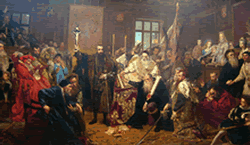
Union of Lublin
In 1392, the city received an important trade privilege from king W?adys?aw Jagie??o, and with the coming of the peace between Poland and Lithuania developed into a trade centre, handling a large portion of commerce between the two countries. In 1474 the area around Lublin was carved out of Sandomierz Voivodeship and combined to form the Lublin Voivodeship, the third voivodeship of Lesser Poland. During the 15th century and 16th century the town grew rapidly. The largest trade fairs of the Polish-Lithuanian Commonwealth were held in Lublin. During the 16th century the noble parliaments (sejm) were held in Lublin several times. On June 26, 1569, one of the most important proclaimed the Union of Lublin, which united Poland and Lithuania. The Lithuanian name for the city is Liublinas.
Some of the artists and writers of the 16th century Polish renaissance lived and worked in Lublin, including Sebastian Klonowic and Jan Kochanowski, who died in the city in 1584. In 1578 the Crown Tribunal, the highest court of the Lesser Poland region, was established in Lublin.
Since the second half of the 16th century, Protestant Reformation movements devolved in Lublin, and a large congregation of Polish Brethren was present in the city. One of Poland's most important Jewish communities was also established in Lublin around this time. Jews established a widely respected yeshiva, Jewish hospital, synagogue, cemetery, and education center (kahal) and built the Grodzka Gate (known as the Jewish Gate) in the historic district. Jews were a vital part of the city's life until they were destroyed in the Nazi Holocaust. Between 1580 and 1764 the Jewish Council of Four Lands Arba Aracot (Sejm of four countries) was held in Lublin in which approximately seventy delegates from local kahals met to discuss taxation and other issues important to Jewish communities.
Students came to Lublin from all over Europe to study at the yeshiva there. The yeshiva became a centre of learning of both Talmud and Kabbalah, leading the city to be called "the Jewish Oxford"; in 1567, the rosh yeshiva (headmaster) received the title of rector from the king along with rights and privileges equal to those of the heads of Polish universities.
In the 17th century, the town declined due to a Russo-Ukrainian invasion in 1655 and a Swedish invasion during the Northern Wars. After the third of the Partitions of Poland in 1795 Lublin was located in the Austrian empire, then since 1809 in the Duchy of Warsaw, and then since 1815 in the Congress Poland under Russian rule. At the beginning of the 19th century new squares, streets, and public buildings were built. In 1877 a railway connection to Warsaw and Kovel and Lublin Station were constructed, spurring industrial development. Lublin's population grew from 28,900 in 1873 to 50,150 in 1897 (including 24,000 Jews).[1]
Russian rule ended in 1915, when the city was occupied by German and Austro-Hungarian armies. After the defeat of the Central Powers in 1918, the first government of independent Poland operated in Lublin for a short time. In the interwar years, the city continued to modernize and its population grew; important industrial enterprises were established, including the first aviation factory in Poland, the Plage i La?kiewicz works, later nationalized as the LWS factory. The Catholic University of Lublin was founded in 1918. The city also contained a vibrant Jewish community that comprised nearly half of Lublin's population.
After the 1939 German invasion of Poland the city found itself in the General Government. During the German occupation the city's population was a target of severe Nazi oppression focusing on Jews. Germans aimed to "Germanise" the city with an influx of ethnic Germans growing toward 20%-25%, compared with 10%-15% in 1939.[2] Near Lublin, a reservation for Jews was built on the Nisko Plan, also known as the "Lublin Plan".
The city served as a headquarters for Operation Reinhardt, the main German effort to exterminate the Jews in occupied Poland. The Jewish population was forced into a ghetto near Podzamcze. The majority of the ghetto's inhabitants, about 26,000 people, was deported to the Be??ec extermination camp between 17 March and 11 April 1942. The remainder were moved to facilities around the Majdanek concentration camp established at the outskirts of the city. Most of them had been murdered by war's end.
Further information: The Holocaust in Poland
After the war, the few surviving Jews in hiding or Soviet territory reestablished a small Jewish community in the city, but it quickly shrank to insignificance, as most Jews left Poland for Israel and the West.
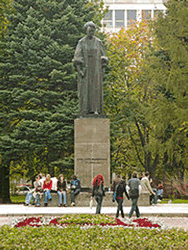
Maria Curie-Sklodowska University
On 24 July 1944, the city was taken by the Soviet Army and became the temporary capital of a Soviet-controlled communist Polish Committee of National Liberation established in the city, which was to serve as basis for a puppet government. The capital was moved to Warsaw in January 1945. In the postwar years Lublin continued to grow, tripling its population and greatly expanding in area. A considerable scientific and research base was established around the newly founded Maria Curie-Sklodowska University. A large automobile factory (FSC) was established in the city.
In July 1960, the workers of Lublin and nearby ?widnik began the first in the wave of mass strikes aimed against the Communist regime, which eventually led to the emergence of the Solidarity movement. The first strike began on July 8 in the WSK factory in ?widnik. It then quickly spread to other factories in Lublin and the surrounding region. The railroad network and city transit came to a standstill. Ultimately, 150 factories employing 70,000 workers joined the strike. The strikers used a novel tactic of staying inside their factories and occupying them, instead of marching in the streets where the authorities would have found it easy to use force against them. The workers made demands for their economic situation to be improved. They also made political demands, such as: new elections for the leadership of the trade unions, liquidation of privileges for the Communist party governing class, and the reduction of the bureaucracy in the factories.
The July strikes lasted two weeks. The Communist authorities eventually managed to bring them to an end peacefully, mainly by granting economic concessions to the workers. However, the momentum generated by the Lublin strikes quickly gave rise to a new wave of strikes in the Gda?sk region in August 1980. The workers there used similar tactics as the Lublin workers used a month before, and this time the Communist authorities had to agree to the strikers' demand to set up an independent trade union, which soon became the Solidarity.
The Lublin region had the lowest per capita GDP in the European Union until Bulgaria and Romania joined in 2007 (it was 32% of EU average in 2002). It is a part of eastern Poland, which has benefited less from the economic transformation after 1989 than regions of Poland located closer to Western Europe. While the standard of living in the city of Lublin is considerably higher than in the surrounding countryside, the city's relatively poor economic performance is tied to the poverty of its region.
Lublin is a regional center of IT companies. Thanks to near 100,000 university students each year and five universities that teach computer science Masters of Arts, Lublin has big supply of specialized work force. Average salary for specialists in Lublin is 2/3 of that in Warsaw (+- 3000 PLN brutto for programmers for example). That makes it a great place for IT companies, and there are many such companies already. Asseco Business Solutions S.A., eLeader Sp z o.o., CompuGroup Medical Polska Sp. z o.o., Abak-Soft Sp. z o.o. and others have their headquarters there. Other companies (for example Comarch S.A., Britenet Sp. z o.o., Simple S.A., Asseco Poland S.A.) outsourced to Lublin, to take advantage of cheap, educated specialists.
Factories built under the Communist regime in the city have performed poorly in the new market economy. The large car factory FSC (Fabryka Samochodów Ci??arowych) seemed to have a brighter future when acquired by the South Korean Daewoo conglomerate in the early 1990s. With Daewoo's financial troubles in 1998 related to the Asian financial crisis, the production at FSC practically collapsed and the factory entered bankruptcy. Efforts to restart its van production succeeded when the engine supplier bought the company to keep its prime market. With the decline of Lublin as a regional industrial centre, the city's economy is being reoriented toward the service industries. Currently, the largest employer is the Maria Curie-Sklodowska University (UMCS).
The prices of land and investing costs are lower than in western Poland. However, the Lublin area is one of main beneficiaries of the EU development funds.[4] Jerzy Kwiecinski, the deputy secretary of state in the Ministry for Regional Development at the Conference of the Ministry for Regional Development (Poland in the European Union — new possibilities for foreign investors) said:
“In the immediate financial outlook, between 2007 and 2013, we will be the largest beneficiaries of the EU — every fifth Euro will be spent in Poland. In total, we will have at our disposal 120 billion EUR, assigned exclusively for post development activities. This sum will be an enormous boost for our country”.[5]
In September 2007, the prime minister signed a bill creating a special economic investment zone in Lublin that offers tax incentives. It is part of “Park Mielec” — the European Economic Development area.[6] At least 13 large companies had declared their wish to invest here, e.g., Carrefour, Comarch, Safo, Asseco, Aliplast, Herbapol and Per?a Browary Lubelskie.[7] At the same time, the energy giant Polska Grupa Energetyczna, which will build Poland's first nuclear power station, is to have its main offices in Lublin.
New shopping centres built in Lublin are Lublin Plaza and Galeria Gala, the largest shopping centre in the city, covering 33500 square metres. Similar investments are planned for the near future such as Park Felin (Felicity) and a new gallery ("Alchemy") between ?wi?toduska and Lubartowska streets.[8]
Television
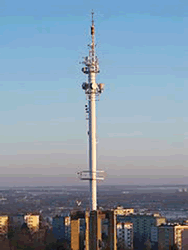
Radio-TV tower in Lublin
TVP Lublin is a TV station in Lublin which owns a 104-metre-tall concrete television tower.[9] It put its first program on the air in 1985. In recent years it contributed programming to TVP3 channel and later TVP Info.
Jewish culture in Lublin
http://teatrnn.pl/leksykon/node/4448
Lublin was an important centre of Jewish culture. Jewish cultural life manifested in various ways - fine arts as well as photographs of Jewish quarter. Famous Jewish theatres, that collaborated with artists known in all Poland, performed in Lublin. What is more, every day Jewish press was published here and many Hebrew printing offices were operating.
The development of fine arts in Jewish quarter in Lublin was double-tracked. One way of development was so-called traditional Jewish art, which means artistic craftsmanship, ornamentation of objects of cult and every day use, treated in a conservative manner, as it was passed from generation to generation. Within this movement, but as a separate issue, comes up funeral art. Another track of development shows up in 20th century, it is modern art, represented by several artists known by name: Symche Binem Trachter, Henryk Lewensztadt and Yehuda Razgour.
Examples of iconography that show Lublin Jewish quarter indicate how much Lublin changed since the wartime, when the Jewish community of Lublin was still alive. Images of Jewish quarter were made not only by Jewish photographers, but also by all those, who were impressed by the ambience of the area.
Cultural needs of Jewish elites in Lublin were satisfied by Jewish theatre, Polish professional theatre and occasional performances of Jewish itinerant groups, that visited the city. There was also an amateur theatre which performed in Lublin.
Also Jewish press was published in Lublin. First Jewish newspaper in Lublin showed up in 1916 and it was 'My?l ?ydowska' ('Jewish Thought'). First journal 'Lubliner Tugblat' ('Lublin Journal') was published for the first time on January 15th 1918.
Already in 16th century Hebrew printing offices were operating in Lublin. Lublin printing office was one of the biggest centres of this kind in Poland.
Compiled by Anna Kiszka
Translated by Magdalena Dziaczkowska
Architecture of the former Jewish quarter in Lublin
http://teatrnn.pl/leksykon/node/3625
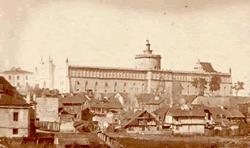
Hardly any remnants of the Jewish quarter, once situated around the castle, have been preserved. Beginnings of Jewish settlement in Lublin date back to the 15th century. The first buildings were constructed in the closest vicinity of the castle hill. Those were low wooden buildings. Gradual sprawling of the Podzamcze district, frequent fires and damage caused by wars and raids prompted intense construction activity in that area.
Synagogues
A synagogue is the most important place for a Jewish community, being not only a temple, but also a meeting place for the qahal members. Synagogues were built according to the established architectural canon that considered all the essential and distinguishing elements, such as the prayer hall with a bimah and women’s gallery. Solomon Luria, who lived in Lublin, was one of the creators of the synagogue building scheme in East-Central Europe. Before the Second World War, eleven synagogues and houses of prayer officially functioned in Lublin. Nevertheless, the most important was the Maharshal and Maharam synagogue complex, situated on Jateczna Street. The brick, two storey building was laid out on a square plan, and covered with pitched roof. The architecture of the synagogue, known in its interwar form, bore marks of restoration carried out in the 19th century.
Among other synagogues located in Podzamcze, there was the Saul Wahl synagogue and the Chewra Nosim synagogue, which still exists today. The Wieniawa district also had its own brick synagogue.
Architecture of the Jewish quarter
The technical documentation of the Buildings Inspection from the 1918-1939 period and pre-war photographs taken in the Jewish quarter show that, as far as style and building materials are concerned, the architecture of the Podzamcze area was strictly related to the architecture of the whole Lublin. No distinctive features had developed.
Apartment houses and public buildings were typical for the architecture of the time when they were constructed. Most of them were built in the 2nd half of the 19th century, when construction activity in Lublin was at its peak. Those buildings were not unlike their neighbourhood outside the Jewish quarter. Actually, succahs are the only visible detail indicating that they were used by Jews.
Buildings on Szeroka, Jateczna, Nadstawna and Lubartowska streets are built of bricks, have three or four storeys, basements, backyards and annexes. The stateliest buildings were located on Szeroka Street, which was the administrative and political centre of Podzamcze. Meanwhile, on Krawiecka and Podzamcze streets, wooden, low, one or two storey buildings predominated. Interesting examples of wooden buildings were houses with balconies, situated, among others, on Krawiecka St.
Relics of the architecture of the Jewish quarter today
Nowadays, the most important buildings related to the Jewish community are: the synagogue on Lubartowska St., the Yeshiva building on Lubartowska St., the Jewish hospital on Lubartowska St. and the former Perec’s House – the Isaac Leib Peretz Jewish Community Centre on Czwartek St. Besides them, there are also the apartment houses in the urban block outlined by Lubartowska, Kowalska, Cyrulicza and Furma?ska streets.
Currently, apart from photographs and technical documentation, information about the architecture of the Jewish quarter can be found in guidebook by Majer Ba?aban, titled ?ydowskie miasto w Lublinie (the Jewish town of Lublin).
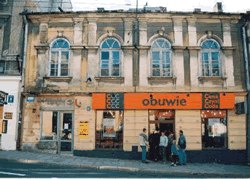
Synagogue on 10, Lubartowska St.
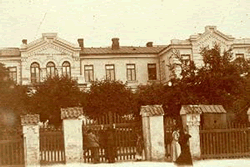
Former Jewish hospital on Lubartowska Street
Text by Joanna Z?tar
Translated by Jaros?aw Koby?ko
Literature
Ba?aban M., ?ydowskie miasto w Lublinie, Lublin 1991.
Bojarski J.J. (red.), ?cie?ki pami?ci, Lublin 2001.
Linkowski G., Hawryluk W., ?ydzi lubelscy. Materia?y z sesji po?wi?conej ?ydom Lubelskim. Lublin 14–16 grudzie? 1994, Lublin 1996.
Radzik T. (red.), ?ydzi w Lublinie t. II. Materia?y do dziejów spo?eczno?ci ?ydowskiej Lublina, Lublin 1998.
Riabinin J., Z dziejów ?ydów Lubelskich, Lublin 1936.
Trzci?ski A., ?ladami zabytków kultury ?ydowskiej na Lubelszczy?nie, Lublin 1990.
Wajs K., Wajs S., Fakty i wydarzenia z ?ycia lubelskich ?ydów, Lublin 1997.
Wajs S., Izba Pami?ci ?ydów Lublina. Lublin ulica Lubartowska 10, Lublin 1990.
Wysok W., Kuwa?ek R., Lublin Jerozolima Królestwa Polskiego, Lublin 2001.
Zieli?ska N., Zieli?ski K., Jeszywas Chachmey Lublin, Lublin 2003.
The Grodzka Gate is an important landmark of Lublin. It used to be called 'the Jewish Gate', as it separated, or rather joined, Christian and Jewish parts of the city, becoming a passage between two different worlds. When in 1992 the NN Theater moved into the Grodzka Gate, its members understood that thus they became responsible for saving memory about Polish and Jewish Lublin.
Table of contents:
1. The Grodzka Gate Heritage
2. The Memory Gate Programme
3. The Memory Gate Portal – Lublin Jews
The Grodzka Gate Heritage
First traces of Jews in Lublin come from the 16th century. The oldest, but not evidenced, trace of Jewish settlement in Lublin is information about king Casimirus the Great's privileges for Jews in 1336. However, the oldest material trace of Jews presence in Lublin is rabbi Jehuda Halevi Kopelman's tombstone from 1541, situated in the old Jewish cemetery.
In the 15th and 16th centuries, the Jewish city began to develop quickly, mainly due to good economic conditions. Nevertheless, already in 1535 Lublin was assigned a De non tolerandis Judeis law,which banned Jews from settling inside the city walls. This contributioned to development of Podzamcze region, surrounding the castle, and educing Jewish district there.
In Lublin, Jews played a vital role in many fields of the city's development. Thiscparticularly concerned religious life, due to which Lublin was called "The Polish Kingdom Jerusalem"; science, thus Lublin was given a name of "Jewish Oxford"; culture – among others, development of one of the first Hebrew printing houses in Poland, and economic life.
The interwar period was a time of big expansion of the Jewish community in Lublin. 15 Jewish schools were open in Lublin at that time, Yiddish newspapers were published, amateur theatre developed. Jews were also active on Lublin political scene.
When the Second World War broke out, 42 000 Jews lived in Lublin, constituting about 1/3 of the city's population.
The Second World War brought about the extermination of Lublin Jews. The destroying of the Jewish district left a vast gap in the city. A few-hundred-year development of bicultural, Polish-Jewish city came to its end. Dozens of years had passed and new Lublin forgot about this Polish-Jewish city, about the crowded streets, houses and synagogues that used to fill empty spaces around the Lublin Castle.
The Memory Gate Programme
The gate is an important sign for us, but also a symbol of the past, so our program aiming at recovering memory about Polish-Jewish Lublin is called "Memory Gate". The program has been driven by the "Grodzka Gate – NN Theatre" Centre since 1990s. It's purpose is to gather and present articles, documents and testimonies related with Lublin Jews, their lives and activities. With time, the Memory Gate program developed and embraced artistic, educational and publishing activities, concentrated around the subject of Jewish cultural heritage in Lublin and Lublin region.
The Memory Gate Portal – Lublin Jews
In order to recover and preserve Lublin and its citizens past, as a part of Memory Gate program, an internet portal Memory Gate – Lublin Jews was created. The portal takes visitors for a walk around the streets of vanished Jewish city in Lublin, shows the spatial arrangement of the Jewish district and presents the most important places related with the Lublin Jewish community.
The portal presents content concerning religious life (houses of prayer,Yeshivah),daily life (how Jews celebrated their religious holidays, such as: Sabbath, Pesah, Yom Kippur, Rosh Hashanah, Sukkot and Simchat Torah as well as Jewish children's games and pastimes), economic life (trade, industry and craftsmanship), political and cultural (traditional Jewish art, modern art, sepulchral art, iconography concerning Lublin Jewish district, Jewish theaters and press) of the Lublin Jewish community.
The Memory Gate Portal – Lublin Jews also provides an opportunity to learn about many Jews who lived in Lublin and who were related with Lublin and contributed to the city's development.
The part on Lublin Jews Holocaust aims at ordering knowledge about Nazi policy of Jews extermination in Lublin district during the Second World War. It includes information about the creation and development of Lublin and Lublin Region ghettos, work camps, concentration camps (Majdanek) and death camps (Be??ec, Sobibór), as well as deportations (Railways and deportations) and a characteristic of the Nazi repression system (Nazis profiles, guards). This part includes also descriptions of activities tending towards the final elimination of Jewish community from the area of General Government ("Operation Reinhard", "Operation Erntefest") and places connected with the Shoah (Lublin Umschlagplatz, Jewish orphanage).
The portal also honors memory of people who – often risking their lives – helped Jews to escape the Holocaust - Righteous among the Nations. (See also site of the project Lights in the Darkness - Righteous among the Nations).
On pages of Memory Gate Portal – Lublin Jews one can also find educational materials for teachers and students, concerning subjects related to the Lublin Region; Lublin Region multiculturality, Lublin culture and history, as well as profiles of people working on the broad subject-matter of Jewish cultural heritage of Lublin and Lublin Region.
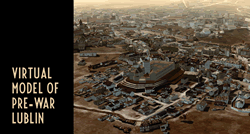
Compiled by
Izabela Czumak, Beata Markiewicz, Tadeusz Przystojecki,
Monika Szab?owska-Zaremba, Agnieszka Wi?niewska.
Materials to the section compiled by
Marzena Baum, Sylwia Bojczuk, Jakub Chmielewski, Anna D?browska, Aleksandra Du?,
Marcin Fedorowicz, Magdalena Grzebalska, Marta Grudzi?ska, Urszula Hasiec, Emilia Kalwi?ska,
Anna Kiszka, Magdalena Ko?uch, Katarzyna Kruk, Monika Krzyka?a, Karolina Kryczka, Beata Markiewicz,
Tomasz Pietrasiewicz, Tadeusz Przystojecki, Agnieszka Stachyra, Monika Szab?owska-Zaremba,
Anna Szl?zak, Piotr Sztajdel, Agnieszka Zachariewicz, Joanna Z?tar.
Remember Jewish Lublin - Genealogy Group
http://chelm.freeyellow.com/lublin.htm
Lublin is the largest city in Poland east of the Vistula River and is located 161 km south of Warsaw.
Jewish life in Lublin dates back to at least the 14th century. In 1453 King Kazimierz Jagiellonczyk
granted the Lublin Jews the privilege of free trade, which in turn resulted in dynamic growth of the
Jewish population in Lublin by the turn of the 16th and 17th centuries. Rabbi Jakub from Trident
settled in Lublin in 1475, indicating that a well-organized kehilla was likely present at the time.
In 1518 constrictions were placed on Jewish trade within Lublin. By 1535 Jews were banned from
living within the walls of the city. This resulted in dynamic growth of the Jewish quarter (Podzamcze).
In 1518 a yeshiva (Talmudical Academy) was established in town and became well known through
Europe. In 1567 the Jewish residents built a brick synagogue on Jateczna Street. A smaller shul
was built nearby as well. In the 16th century a large part of Podzamcze was flooded by the
Czechowka River. The Jewish quarter expanded to the drained marshy lands around the castle.
Jewish houses were also built in the suburb of Kalinowszczyzna, located northeast of the city.
Moshe Montalto, a Sephardic physician who settled in Poland in the 17th century, built a synagogue
in Lublin where the congregants prayed in the Sephardic rite. See also: Sephardic Jews in Poland.
In the late 15th century the old Jewish cemetery in Lublin was established. The Council of Four Lands,
the central body of Jewish authority in Poland from 1580 to 1764, met in Lublin. In 1655, the town
was burned by the Muscovite-Cossack Army, resulting in the murders of around 2,000 Jews. In 1656
the Swedish Army wreaked havoc on the Jewish community. Constant economic restrictions from
the local authorities aimed to prevent the development of Jewish trade. The Lublin kehilla was only
fully restored in the second half of the 18th century. At the turn of the 18th and 19th centuries Lublin
became an important center of Hasidic Judaism in accordance with the teachings of Baal Shem Tov
and the preachings of his follower Jacob Icek Horowitz, the Seer from Lublin. At the beginning of the
20th century the richest and most assimilated Jews in Lublin possessed large tenement houses,
breweries, mills, tanneries, tobacco plants, and numerous stores in the whole town area. However,
the majority of Jews in town were poor, traditionally religious, poorly educated, and somewhat isolated
from the Polish culture -- living within only the Jewish quarter of town. In the second half of the 19th
century the Jews from Lublin maintained their own schools, newspapers, social associations, and
sports clubs. In 1886 a Jewish hospital was built on Lubartowska Street. In 1916 there were
already 15 private Jewish schools. Jews manufactured clothing and food products, had a monopoly
on the leather industry, and ran tobacco plants, distilleries, and brickyards. After World War I there
were a number of educational facilities in the city, including Hashomir Hatzair, Tarbut Hebrew School,
Mizrachi's Yavne School, and Beth Jacob School for Girls. From the beginning of WWI up to the
Nazi invasion, Jews in Lublin were faced with tremendous anti-Semitism. Jews were assaulted by
mobs, Jewish businesses were boycotted, and Jewish property was pillaged by the Cossacks. In
1921, the Jewish population was 37,337, with Jews operating 1,714 workshops and businesses in
the city. The Jewish community was supported by 12 synagogues, an array of private prayer houses,
a hospital, an orphanage, three cemeteries, a network of schools and the Chachmei yeshiva. Inspired
by Lublin's substance, novelist Isaac Bashevis Singer wrote a book called "The Magician of Lublin".
Prior to WWII, Lublin was the center of religious life for thousands of Jewish families. Students came
from all over Europe to study at the yeshiva in the city. In 1931 Lublin was inhabited by 38,937 Jews
who constituted 35% of the overall town population. By 1939, the population of Jews in Lublin reached
more than 42,000 -- about 1/3 of the total city population. In November 1939, Jews living in the center
of the city (including Krakowskie Przedmiescie and its side streets) were forced to relocate to the
traditionally Jewish Podzamcze district. Soon, the Jews were beset by a series of repressive measures.
Lublin became a regional Nazi headquarters for Operation Reinhardt, the main effort to murder Jews
in occupied Poland. Jews were stigmatized with Star of David armbands, a work requirement was
imposed, the use of public transportation and public facilities was prohibited, bank accounts were
closed, religious practice was forbidden, access to educational institutions was denied, involuntary
monetary and material contributions were demanded and, eventually, Jewish enterprises and real
estate were seized. In the beginning of 1940, a Judenrat was created, comprised of 24 members and
headed by Henryk Bekker and Marek Alten. The Judenrat headquarters was at 11 Grodzka Street.
Other Judenrat members in Lublin were: Aron Bach, Aizik Brodt, Aizik Bursztyn, Urysz Cymerman,
Dawid Dawidson, Dawid Edelstein, Dawid Frajdenberg, Abraham Goldsobel, Jozef Goldztern, Szlomo
Halbersztadt, David Hochgemein, Leon Hufnagel, Aron Jankiel Kantor, Yitzhak Kerszman, Szloma
Kerszenblum, Shlomo Kestenberg, Jacob Kelner, Daniel Kupferminc, Aleksander Lewi, Yitzchak
Lewinson, Nachman Lerner, Dawid Rechtman, Josef Rotrubin, Dr. Josef Siegfried, M. Sztokfisz,
Moritz Szlaf, Szulim Tajkef, Benzion "Boleslaw" Tenenbaum, Josef Wajselfisz, and Wolf Wiener. The
Judenrats in the Lublin district, in general, were not complicit with the Nazis and resisted when possible.
In March 1941, Ernst Zoerner, the governor of Lublin, announced that "a Jewish residential district"
that encompassed the Podzamcze district (to Lubartowska Street) and a section of the Old Town. The
creation of the ghetto was preceded by the resettlement of approximately 10,000 Jews from the Lublin
district. During the entire time the Lublin Ghetto existed, it was never completely sealed; however, the
concentration of an almost 40,000-person population in such a small area contributed to terribly
cramped living conditions and worsening sanitary and hygienic conditions which led to the outbreak
epidemics which, in turn, when combined with rampant hunger and debilitating work, decimated the
population of Lublin's Jewish quarter. The first major deportation from the Lublin ghetto began on
March 16-17, 1942. During the month-long deportation operation (that lasted until mid-April 1942)
approximately 30,000 Jews from the Lublin ghetto were sent to the Belzec Death Camp, while about
1500 others were shot on the spot. The remaining 4,000 Jews were transferred to Majdan Tatarski.
The fate of the Majdan Tatarski ghetto was decided on November 9, 1942. Most of its inhabitants were
sent to the Majdanek Concentration Camp on foot. After the final liquidation of the Majdan Tatarski
Ghetto, it was burnt to the ground. On September 2, 1942, 2,000 Jews were murdered and another
1,800 were murdered in October of 1942. The remaining 200 Jews were sent to the Majdanek Camp.
Others in in the Lublin area were taken to the New Cemetery and shot execution style or buried alive.
"Erntefest", Operation Harvest Festival, began at dawn on November 3, 1943. "Erntefest" was the code
name for the Nazi operation to kill all Jews remaining in the Lublin District of the Generalgouvernement
(a territory in the interior of occupied Poland) in the fall of 1943. The timing of the operation was in
response to several efforts by surviving Jews to resist the Nazis: including the uprisings at the Sobibor
and Treblinka extermination camps, and armed resistance in the Warsaw, Bialystok, and Vilna ghettos.
The SS feared additional Jewish-led revolts in the Generalgouvernement. To prevent further resistance,
the SS decided to kill most of the remaining Jews, who were employed in forced labor projects and were
concentrated in the Trawniki, Poniatowa, and Majdanek concentration camps. Trawniki and Poniatowa
were surrounded by S.S. and police units. Jews were then taken out of the camps in groups and shot
in nearby pits dug for this purpose. At Majdanek, Jews were first separated from the other prisoners.
They were then taken in groups to nearby trenches and shot. Jews from other labor camps in the Lublin
area were also taken to Majdanek and shot. Music was played through loudspeakers at both Majdanek
and Trawniki to drown out the noise of the mass shooting. The killing operation was completed in a single
day at Majdanek and Trawniki. At Poniatowa the shootings took two days. End result: 42,000 Jews killed.
At the beginning of August, 1944, about 300 Jews were living in Lublin, but only 15 were originally from
Lublin. The number grew to 3,000 Jews by 1945 as refugees from other places repopulated Lublin.
The Nazis in charge of--
for the rest go to http://chelm.freeyellow.com/lublin.html
